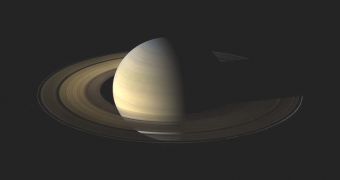New studies appear to demonstrate that the intricate patterns carved up in the rings of the gas giant Saturn are somehow connected to the history of the solar system. More than 400 years after Galileo first discovered the enormous planet, researchers are starting to get new insight into how the two are related. This is only possible due to the contributions that telescopes such as Hubble and spacecraft such as the NASA/ESA Cassini space probe have brought to science, the BBC News reports.
The rings system surrounding Saturn is the best developed in the entire solar system, and they are made out of billions upon billions of very small ice particles, which agglomerate in very peculiar patterns. They create rings that are up to 70,000 kilometers wide, but which at some points are only 3 meters (roughly 10 feet) thick. This was extremely interesting for astronomers when they first looked closely at the structures. At equinox, when sunlight falls directly on the Saturnine equator, the rings become invisible, as they are seen edge-on from Earth. At this point, we have no telescope capable of making out a 3-meter-thick structure all the way to the middle of the solar system.
One of the best possible spots on our planet to identify with the famous rings is a glacial lagoon in Iceland, which was used as a shooting site for the BBC2's Wonders of the Solar System – Order Out of Chaos show. Brian Cox, the host of the TV show, said that the location left a deep impression on him. “I climbed up a floating iceberg in the lagoon and was left there alone whilst we did a series of sweeping helicopter shots. It was a magical and quiet place (until the helicopter flew past) and I allowed my mind to drift. The rings are magnificently pure water-ice, just like the icebergs, and I genuinely felt transported three-quarters of a billion miles away to the rings of Saturn,” he said.
But the similarities between the two locations are more than just aesthetically pleasing. Scientists plan to use data they collect from the lagoon as a starting point for understanding how the massive planetary rings relate to the earliest days of the solar system. It was first born into chaos, but then all the planets aligned themselves into an ordered manner, and the precise same pattern is seen in the rings. “In the rings, we're learning something about our own origins. Because the physical processes that go on in the rings are probably similar to what went on in the early Solar System and we've got this incredible opportunity to observe those processes happening in front of our eyes,” says Queen Mary, University of London-based Cassini scientist, Carly Murray.

 14 DAY TRIAL //
14 DAY TRIAL //